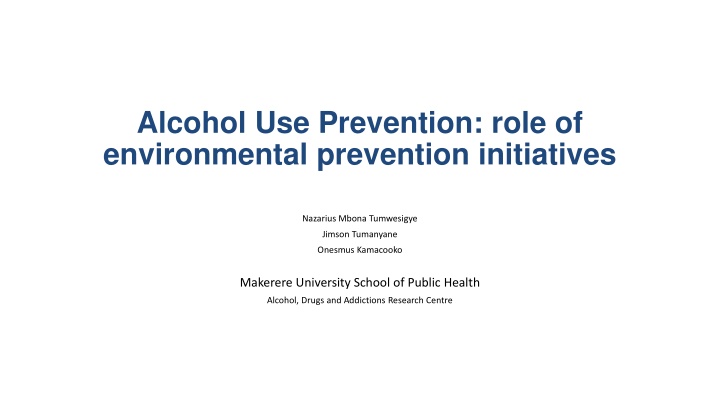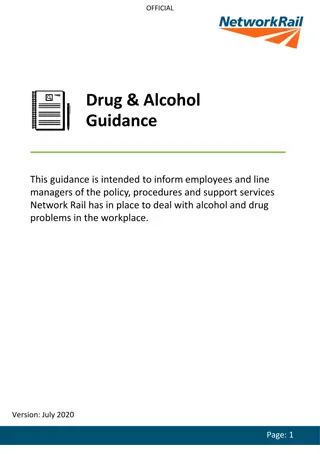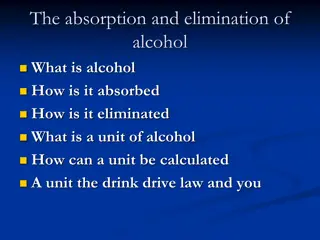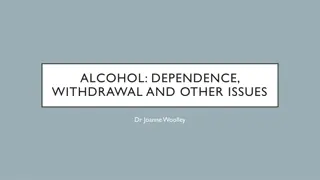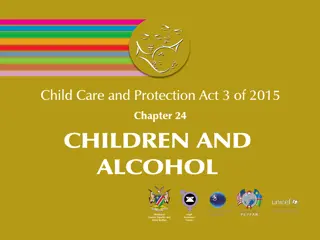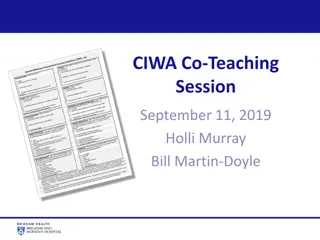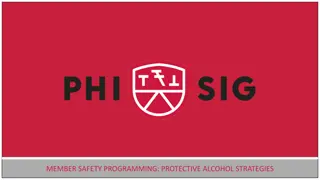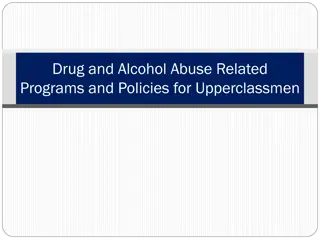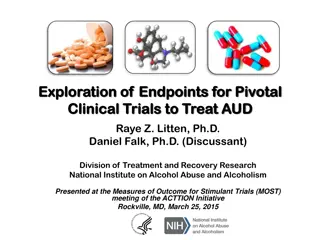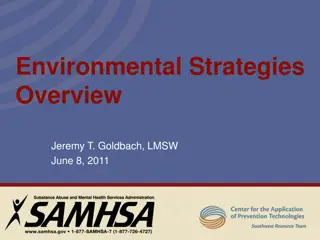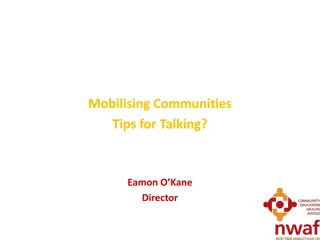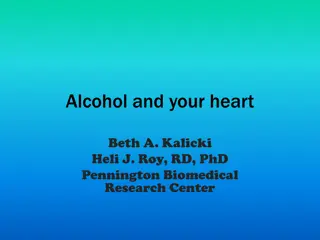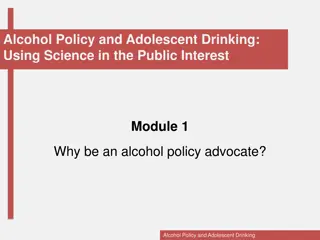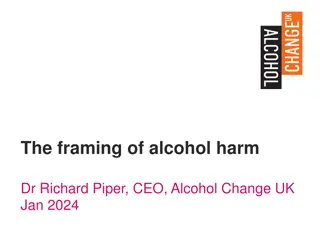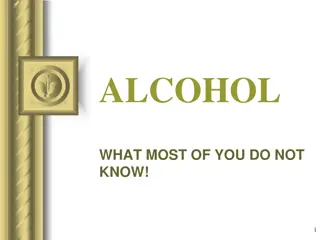Role of Environmental Prevention Initiatives in Alcohol Use Prevention
Environmental prevention initiatives play a crucial role in alcohol use prevention by implementing strategies such as setting minimum prices, taxation, and enforcing minimum legal drinking ages. These initiatives aim to reduce the availability, affordability, and attractiveness of alcohol, ultimately decreasing alcohol-related harms.
Download Presentation

Please find below an Image/Link to download the presentation.
The content on the website is provided AS IS for your information and personal use only. It may not be sold, licensed, or shared on other websites without obtaining consent from the author.If you encounter any issues during the download, it is possible that the publisher has removed the file from their server.
You are allowed to download the files provided on this website for personal or commercial use, subject to the condition that they are used lawfully. All files are the property of their respective owners.
The content on the website is provided AS IS for your information and personal use only. It may not be sold, licensed, or shared on other websites without obtaining consent from the author.
E N D
Presentation Transcript
Alcohol Use Prevention: role of environmental prevention initiatives Nazarius Mbona Tumwesigye Jimson Tumanyane Onesmus Kamacooko Makerere University School of Public Health Alcohol, Drugs and Addictions Research Centre
Environmental prevention initiatives These kinds of interventions can be established at the state and local governmental levels and supported by a broad range of community-based organizations Enforcement of the minimum legal drinking of 21 years. restrictions on licensing businesses that sell alcohol restrictions on hours of operation of licensed businesses that sell alcohol increased alcoholic beverage prices Other policy related interventions 2
Environmental prevention initiatives Increase in Purchase prices: This has been found to reduce the incidence of injuries (Stockwell et al 2012) Reducing affordability: Numerous studies have shown the price of alcohol has a significant impact on rates of consumption (WHO, 2014). The cheaper the alcohol, the more likely people are to buy higher quantities(Swahn, Palmier, Benegas-Segarra, & Sinson, 2013) Taxation: . WHO recommended that alcohol tax systems take into account the alcohol content of each type of beverage (WHO, 2010). 3
Environmental prevention initiatives Contd Setting minimum prices on alcohol: WHO s global strategy recommended establishing minimum prices for alcohol, and index these prices to inflation. A study found that a 10% increase in the price an alcoholic drink resulted in a 16.1% decrease in its consumption relative to other drinks (Stockwell, Auld, Zhao, & Martin, 2012). Ban products that are likely to attract the vulnerable: Sachets are directly marketed at youth and the poor who are less able to afford bottled spirits (Swahn, Palmier, & Kasirye, 2013). These have been banned in Uganda and there is anecdotal information to show reduced harm due to alcohol 4
Prevention initiatives contd Minimum drinking age: Establishing a minimum drinking age is endorsed by the WHO s global alcohol harm reduction strategy: while Uganda currently has an official minimum drinking age of 18 (see the 1960 liquor act), enforcement is weak (Tessa Laing, 2015). Limiting the Blood Alcohol Concentration (BAC) for drivers- , lowering the alcohol blood limit from 0.10 to 0.08 reduced the number of alcohol related crashes by 5-16% (Fell & Voas, 2006)- Uganda s official limit is 0.08%, but is not enforced uniformly across the country (Tessa Laing, 2015). 5
Environmental protection initiatives Create more awareness- radio talk shows, dissemination workshops, social media Limiting access: limiting the number of outlets (bars, shops etc) that sell alcohol can limit consumption, and reduce the level of harm caused by alcohol (WHO, 2014). For each unit increase in outlet density per 10,000 persons, there was a 0.48 increase in morbidity per 10,000 persons (Tatlow, Clapp, & Hohman, 2000). Limiting days and hours of sale- A study in Western Australia showed that extending opening hours from 24:00 to 01:00 increased violent incidents at the late-night venues by 70% (Chikritzhs & Stockwell, 2002). 6
Challenges Challenges These laws are weak, outdated, and most significantly Rarely enforced. The fines for offenses are too small. In Uganda s case Enguli and Liquor Acts range from US 15 cents A low proportion know of alcohol use restrictions 7
References WHO. (2014). Global status report on alcohol and health-2014: World Health Organization. Geneva, Switzerland. Swahn, M. H., Palmier, J. B., Benegas-Segarra, A., & Sinson, F. A. (2013). Alcohol marketing and drunkenness among students in the Philippines: findings from the nationally representative Global School-based Student Health Survey. BMC public health, 13(1), 1159. WHO. (2010). European status report on alcohol and health 2010. Stockwell, T., Zhao, J., Martin, G., Macdonald, S., Vallance, K., Treno, A., . . . Buxton, J. (2013). Minimum alcohol prices and outlet densities in British Columbia, Canada: estimated impacts on alcohol-attributable hospital admissions. Am J Public Health, 103(11), 2014-2020. doi: 10.2105/ajph.2013.301289 Swahn, M. H., Palmier, J. B., & Kasirye, R. (2013). Alcohol exposures, alcohol marketing, and their associations with problem drinking and drunkenness among youth living in the slums of Kampala, Uganda. ISRN Public Health, 2013 Tessa Laing, L. N. (2015). Tessa, L., Laing, N (2015). Towards an Alcohol Ordinance Report of Gulu District Council. Gulu, Uganda: Gulu District Council Fell, J. C., & Voas, R. B. (2006). The effectiveness of reducing illegal blood alcohol concentration (BAC) limits for driving: evidence for lowering the limit to. 05 BAC. Journal of safety research, 37(3), 233-243 Tatlow, J. R., Clapp, J. D., & Hohman, M. M. (2000). The relationship between the geographic density of alcohol outlets and alcohol-related hospital admissions in San Diego County. Journal of community health, 25(1), 79-88 Chikritzhs, T., & Stockwell, T. (2002). The impact of later trading hours for Australian public houses (hotels) on levels of violence. Journal of studies on alcohol, 63(5), 591-599 8
